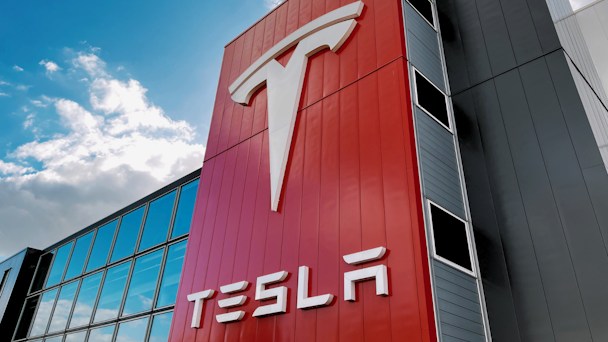Major layoffs, Cybertruck recall & slumping revenue paint a picture of Tesla in turmoil
On Tuesday, the automaker reported its worst revenue decline in 12 years, while an internal source predicts more layoffs are on the horizon.

Tesla’s stock has dropped nearly 42% since the start of the year
Tesla has had a tumultuous start to 2024. The electric vehicle manufacturer and the world’s most valuable automaker reported its first-quarter financial results on Tuesday, revealing a 9% dip in revenue – the largest slump it has seen since 2012.
Revenue for the quarter fell $25.17bn year-over-year (YoY) to $21.3bn, below London Stock Exchange Group (LSEG) analyst estimates of $22.15bn. Earnings per share for the period were 45 cents adjusted, compared with an LSEG projection of 51 cents. Profits tumbled 55%.
Company leadership sought to assuage concerns by asserting their confidence in Tesla’s longer-term performance. The company also teased its forthcoming robotaxi ride-hailing service, slated to debut in August.
Tesla’s stock has dropped nearly 42% since the start of the year. The company has seen sales slow and margins narrow amid a slowdown in EV adoption in the US, economic pressures exacerbated by high interest rates and intensifying competition from car manufacturers in markets such as China. The company’s 2024 sales downturn is worse than it was at the height of the pandemic in 2020 when production was significantly disrupted.
The vehicle manufacturer, owned and headed by mercurial billionaire Elon Musk, is also facing various trust and public relations headaches.
Late last week, the company recalled every Cybertruck it has sold since the boxy, futuristic vehicle was introduced in November – tallying nearly 4,000 – over a mechanical problem that risked the accelerator getting stuck at full throttle. Though the company has been quick to remedy the defect with a simple rivet installation, the incident garnered backlash for Tesla during an already difficult period.
Meanwhile, Musk himself generates relatively consistent backlash for his divisive behavior on and about X, the platform formerly known as Twitter, which he acquired in late 2022.
Tesla is very clearly scrambling to make up lost ground. The automaker spent the weekend slashing the prices of its Model Y, Model X and Model S vehicles by $2,000, as well as the price of its Full Self-Driving software, in an effort to correct course on an 8.5% YoY drop in first-quarter vehicle deliveries.
In another drastic move, the company announced on April 15 that it would lay off over 10% of its global workforce, affecting some 14,000 employees.
The layoffs serve as a kind of “financial release valve” for its recent financial missteps, says Gadjo C Sevilla, senior technology analyst at eMarketer. However, a report from Bloomberg suggests that Musk personally wanted to cut as much as 20% of Tesla’s workforce, which would match the company’s sales dip between Q4 of 2023 and Q1 of 2024.
Affected divisions include customer service and post-sales support, as well as Tesla’s nascent marketing operation, which was reportedly scrapped in its entirety. Dubbed the ‘growth content’ team, the approximately 40-member group was headed by Alexander Ingram. The team led Tesla’s first foray into advertising following Musk’s announcement last May that the company would begin marketing its products.
“A universal layoff approach based on cost shows a certain amount of panic,” says Greg Silverman, global director of brand economics at Omnicom-owned brand consultancy Interbrand.
The decision to slash the company’s marketing department en masse also won’t help Tesla win any of the PR battles it is currently fighting or might face in the future, says Silverman. “A way to bolster the bottom line and minimize PR issues would be to have a marketing department building brand equity away from Elon Musk’s persona,” he says. “100% cuts [to marketing personnel] appear as a gross overreaction to faltering business conditions.”
Layoffs also hint at Musk’s reticence in light of high inflation in key markets around the world, according to a Tesla employee who spoke to The Drum on the condition of anonymity. High interest rates are, in Musk’s eyes, a key culprit of lagging sales, the source says.
The source expects that the company will undergo additional rounds of layoffs – or will incentivize employees to leave – every three to six months, so long as interest rates remain high.
Market analysts appear skeptical that the Federal Reserve, set to meet this month, will cut rates. Fed Chair Jerome Powell said at a press conference last month that elevated rates “haven’t really changed the overall story … of inflation moving down gradually on a sometimes-bumpy road to 2%.”
Just two days after layoffs were announced, Tesla petitioned shareholders to vote to re-approve Musk’s historically large $56bn compensation package. The plan was previously struck down in January by a Delaware judge over governance concerns. Now, the timing of the request to investors has put a bad taste in some consumers’ mouths, who voiced their disapproval on social media.
Now, it’s clear that Tesla is facing a swath of business problems that are only being compounded by PR woes.
“Tesla’s board and management need to make significant changes to right the ship,” says eMarketer’s Sevilla. “Whether that’s …. defining a solid product strategy or compelling Musk to focus his attention on Tesla and its issues.”
For the time being, Sevilla says, “Tesla is in a period of correction and needs to tread carefully to avoid sales slumping further.”
Internally, the source who spoke with The Drum says that the mood at Tesla remains largely focused. Most employees, they say, expect periods of low growth to give way, eventually, to periods of high growth.
Despite its lackluster first-quarter financial results, Tesla saw its stock spike up to 11% in after-hours trading on the heels of an announcement that it will accelerate the debut of more affordable models.
Sevilla suggests that the company’s renewed commitment to more cost-accessible models, paired with cost-cutting across the existing vehicle lineup and self-driving service, could boost investors’ confidence in the coming months.
However, the company didn’t share explicit details about when these cheaper vehicles will roll out. As competition in the electric vehicles category reaches new heights in the US and China, timing is sure to make a real difference for Tesla.
“Q2 will be a lot better,” Musk promised in a call with investors on Tuesday afternoon.

